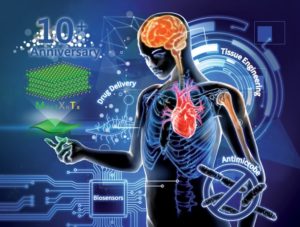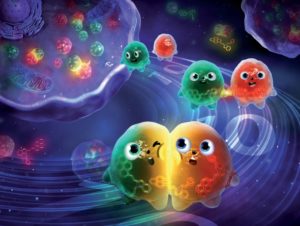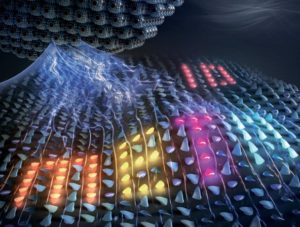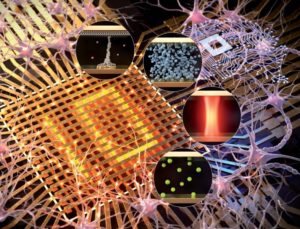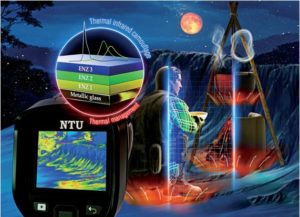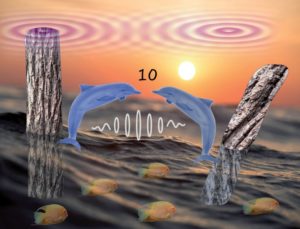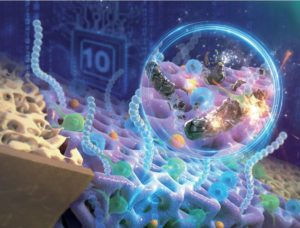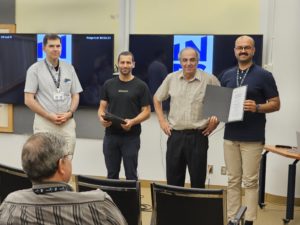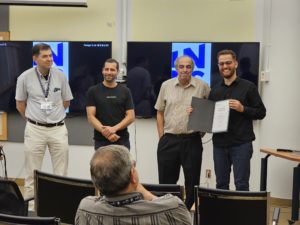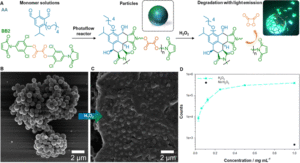Perovskite oxynitrides are intriguing materials with significant relevance in photoelectrochemistry and catalysis. Their crystallinity is often simplified using high-symmetry unit cells as a convenient approximation. However, this approach fails to capture the complex local atomic displacements of anions and neighboring cations caused by the differing ionic radii of oxygen and nitrogen anions. A recent study by the Seitz Group provides a more nuanced understanding of perovskite oxynitrides’ true crystallinity, using a newly synthesized calcium tungsten oxynitride, CaW(O,N)3, as a model system. The authors leverage experimental and computational techniques to explore its crystal structure, focusing on distortion, anion ordering, and symmetry. This study highlights four key findings:
CaW(O,N)3 exhibits structural distortion. The study marks the first successful synthesis of CaW(O,N)3. Using a combination of density functional theory (DFT), X-ray diffraction (XRD), and neutron diffraction (ND), the authors reveal that this material adopts an orthorhombic Pnma average structure. This structure exhibits significant octahedral distortion and preferential anion site occupancy, highlighting its deviation from a purely symmetric model.
Symmetry models for perovskite oxynitrides need to account for disorder. The authors demonstrate that traditional high-symmetry models fail to capture the full complexity of CaW(O,N)3. Instead, a low-symmetry model with a P1 space group—which incorporates a larger unit cell and random anion positioning—better represents the disorder inherent in the crystal. This disorder forms a “polymorphous network,” where the observed high symmetry is only an average, masking the true lower local symmetry of CaW(O,N)3.
The structural disorder can be extended to other perovskite oxynitrides. The structural disorder observed in CaW(O,N)3 was also identified in its analog, SrW(O,N)3. Like CaW(O,N)3, the authors obtained a better representation of the structural disorder in SrW(O,N)3 by applying similar low-symmetry models, suggesting that such disorder is a common characteristic across perovskite oxynitrides.
Structural disorder in perovskite oxynitrides causes changes in electronic properties. Comparative X-ray Absorption Spectroscopy (XAS) revealed differences in electronic structures between Ca- and Sr-based perovskite oxynitrides. SrW(O,N)3 exhibits stronger covalency between its anions and W 5d orbitals. These differences are attributed to the distinct electronic configurations and ionic radii of Ca²⁺ and Sr²⁺, which alter the interaction of W with neighboring anions.
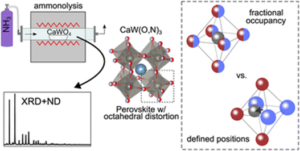
Figure 1. summarises the study using CaW(O,N)3, as a model system. Experimental and computational techniques are used to explore its crystal structure, focusing on distortion, anion ordering, and symmetry. Image reproduced from DOI: 10.1039/D4MH00317A with permission from the Royal Society of Chemistry.
In summary, this study provides a comprehensive evaluation of the crystallinity and electronic properties of perovskite oxynitrides, emphasizing the importance of structural disorder. This work is a must-read for researchers studying heteroanionic materials, offering guidance on characterizing their structural and electronic properties through essential experimental and computational methods. Furthermore, it underscores the need for more sophisticated models to accurately represent these materials’ symmetry and local structure, accounting for the inherent complexities introduced by mixed anion occupancy. These findings are crucial for optimizing perovskite oxynitrides’ performance in catalytic and photoelectrochemical applications, where electronic and structural properties are pivotal in their performance.
To find out more, please read:
Synthesis and symmetry of perovskite oxynitride CaW(O,N)3
Matthew E. Sweers, Tzu-chen Liu, Jiahong Shen, Bingzhang Lu, John W. Freeland, Christopher Wolverton, Gabriela B. Gonzalez Aviles, and Linsey C. Seitz
Mater. Horiz., 2024,11, 4104-4114 DOI: 10.1039/D4MH00317A
About the blogger

Raul A. Marquez is a Ph.D. in Chemistry candidate working with Prof. C. Buddie Mullins at The University of Texas at Austin and a Materials Horizons Community Board member. His research focuses on understanding the transformations of electrocatalytic materials and developing advanced characterization methods for energy storage and conversion technologies. Follow Raul’s latest research on LinkedIn.
|



















